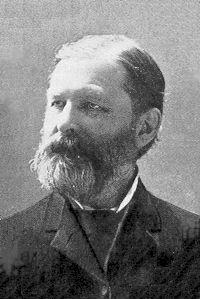


Robert Lowry
Repertoire:
Shall We Gather at the River?
Nothing But the Blood
Shall We Gather at the River?
Christ Arose
Follow On
We're Marching to Zion
I Need Thee Every Hour
All the Way My Savior Leads Me
(March 1826 – November 1899)
Robert Lowry was born in Philadelphia, PA. March 12, 1826. He was a Baptist minister, composer of gospel hymns, and a Professor of Literature. He was married and had three sons. Lowry died at home in Plainfield, New Jersey on November 23, 1899 and is buried at Hillside Cemetery.
Robert was saved at the age of seventeen. Although his parents were members of the Presbyterian Church, his study of the Scriptures led him to baptism and membership with the Baptists. He was baptized by Rev. George B. Ide, D. D., and joined the First Baptist Church in Philadelphia, soon becoming active as a Sunday School teacher and choir member. As he grew in his faith, his desire to consecrate his life in service to Christ became stronger. He was encouraged by his Pastor and soon surrendered to the ministry. He entered the University of Lewisburg (now Bucknell University) to prepare. Lowry graduated in 1854 with the highest honors of his class. That same year he was ordained and became pastor of the First Baptist Church, West Chester, PA. In 1858, he accepted the call to be the Pastor of the Bloomingdale Baptist Church in New York serving there until 1861. In that year, he was called as pastor of the Hanson Place Baptist Church in Brooklyn, NY. In 1869, he became Professor of Literature at his alma mater and was called to be the pastor of Lewisburg Baptist Church. He later became Chancellor of the University. He remained in Lewisburg until 1875 and then relocated to Plainfield, N. J. to help organize a new church, Park Avenue Baptist Church. He served as President of the New Jersey Baptist Sunday School Union from 1880 until 1886.
Dr. Lowry was a man of many gifts and talents. He was an excellent preacher, very knowledgeable in the Bible, and always a brilliant and interesting speaker. Many reports state that he had few peers in his ability to paint pictures for the imagination. He could challenge an audience with his vivid descriptions, inspiring others with the same thoughts that inspired him. As a Pastor, Dr. Lowry developed the skill of recognizing and helping to develop talent of those in his congregations. At the Hanson Place Baptist Church, he encouraged and wrote songs with Annie Hawks. He also established a similar partnership with Fanny J. Crosby at Sixth Avenue Bible Baptist Church in Brooklyn, New York.
He was later asked to become Music Editor at the Biglow and Main Publishing Company, one of the earliest sacred music publishing companies in America. He hesitated at first due to his fear that the work would hinder his work as a Pastor, but he accepted and in this position he was responsible for more than 500 compositions. These included words and music for many songs including “Nothing but the Blood,” “Shall We Gather at the River?,” and “Christ Arose” (Low in the Grave He Lay). He supplied the music for others such as “Follow On” (Down in the Valley) by William O. Cushing, “We’re Marching to Zion” for the words by Isaac Watts, “I Need Thee Every Hour” by Annie Hawks, and “All the Way My Savior Leads Me” with Fanny Crosby.
“Shall We Gather at the River?” is perhaps the most popular of all his songs. But Lowry said of that song: “It is brass band music, has a march movement, and for that reason has become popular, though for myself I do not think much of it.” But it was his pastoral duties and actions that led him to write and compose that wonderful song full of hope and promise. It was an extremely hot and humid day in July, 1864, and a deadly cholera epidemic was claiming many lives in Brooklyn. As Pastor of Hanson Place Baptist Church, he was called upon to visit many bereaved families as death entered their homes. He knew the Lord gave him the strength and the words to say. Each time, the Pastor would assure the sick and sorrowing that through faith in Christ they can look forward to a great reunion day at the river of life described in the book of Revelation. He encouraged them to think of meeting the departed once again by the river. He recalled that one day he was resting at home when he began thinking of those that were dying and the separation that was created. As he rested, his thoughts were led to an eternal future and all that be involved. This led him on to consider the second coming of Christ, of God on His throne, the gathering of the saints, and the river of life. He said that he wondered why the hymn writers had written so much about “the river of death,” and so little about “the pure river of water of life, clear as crystal, proceeding out of the throne of God, and of the Lamb.” He said that as he thought, the ideas began to construct themselves. First the question, “Shall we gather?” Then the thought immediately followed as an answer of Christian faith, “Yes, we’ll gather.” On this question and answer the hymn developed itself, seemingly the music and the words were formed together. When it was completed, he put it aside. Later that same year he was asked for some contributions for a songbook; he gave the editor some manuscripts and only as an afterthought, he added his new song, “Shall We Gather at the River?” The next spring the Brooklyn Sunday School Union asked permission to use it for their May Anniversary. It was estimated that forty thousand teachers and children sang it during the meeting and in their churches that year. It was instantly popular being sung in conventions, churches, and Sunday Schools. In just a short time the song became known wherever the Gospel was preached.
His melodies are known world-wide and many of his hymns have been translated into foreign languages. But despite his success as a hymn writer, Dr. Lowry said, “Music, with me has been a side issue. I would rather preach a gospel sermon to an appreciative audience than write a hymn. I have always looked upon myself as a preacher and felt a sort of depreciation when I began to be known more as a composer.” Yet despite his preference, his hymns continue to be as popular as ever and widely used, being translated into many languages. In them he preaches to and comforts millions of souls. We sing his words as we express deep feelings of praise and gratitude to God for His goodness. What he had thought in his Pastor’s heart and put onto paper, has become a part of the emotions of the whole Christian world. We are all his debtors.
Shall We Gather at the River?
Yes, we’ll gather at the river,
The beautiful, the beautiful river;
Gather with the saints at the river
That flows by the throne of God.
Bibliography
Biography of Gospel Song and Hymn Writers, J. H. Hall. New York: Fleming H. Revell, ©1914.
A Treasure of Hymns, Amos R. Wells
The Story of the Tunes, Hezekiah Butterworth. New York: American Tract Society, 1890.
Baptist Hymn Writers and Their Hymns, Henry S. Burrage. Portland, Maine: Brown, Thurston & Co., 1888, pp. 428–434.
www.hymntime.com.
www.wordwisehymns.com
